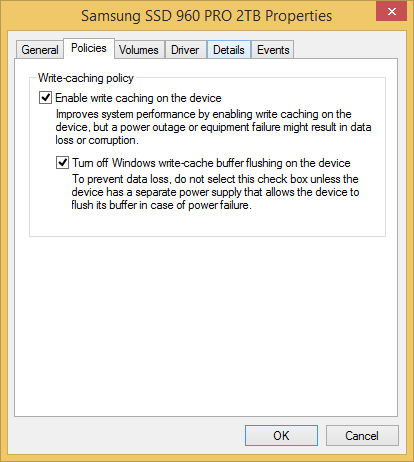The Samsung 960 Pro (2TB) SSD Review
by Billy Tallis on October 18, 2016 10:00 AM ESTA Note About Drivers
The Intel SSD 750, the Samsung 950 Pro and the OCZ RD400 were all reviewed with the NVMe drivers supplied by the SSD vendors. In the past, vendors have sometimes cited performance as an advantage to using their NVMe driver over the one built in to Windows, but the primary reason has been that Microsoft's driver implements a limited feature set. The driver that was made available as an update to add NVMe support to Windows 7 SP1 and Windows Server 2008 SP1 did not include the necessary interfaces for updating SSD firmware, and even on Windows 8.1 and later the vendor-specific management tools require their own driver for performing tasks like a secure erase.
Samsung's NVMe driver for the 960 Pro was not ready in time for this review. They are planning to release it in mid-November in conjunction with their Magician 5.0 utility. The Samsung NVMe driver will be required to support Magician 5.0's new "Magic Vault" secure archive/backup feature and the new secure file erase feature.
In the meantime, rather than try to hack Samsung's NVMe driver for the 950 Pro to work with the 960 Pro, this review is relying on Microsoft's NVMe driver built-in to Windows 8.1. While most SSD vendors (especially the smaller ones) now say that Microsoft's NVMe driver offers adequate performance and that there is no need for a custom driver to get full performance, there are some pitfalls.
Windows provides two settings for drive write caching policy. By default, write caching is enabled on internal drives and there is an unselected option to turn off write cache buffer flushing. Both options have warnings attached about the possibility of data loss in the event of a power failure. It is normal for SSDs to cache and combine writes rather than immediately send all written data straight to the flash, and this is necessary to overcome the fact that NAND flash write operations are inherently much slower than read operations. Without write caching on the SSD, we would never see good random write performance, let alone random write performance that exceeds random read performance.
The default write caching policy settings work fine for SATA SSDs. This is not the case for NVMe SSDs when using Microsoft's driver. Microsoft's NVMe driver in the default configuration is extremely conservative about write caching, leading to extremely poor performance on some tests. Checking the second box gives performance that is as expected while leaving it unchecked for a high-end NVMe drive can lead to worse performance than a low-end SATA drive. Normally I would not review a drive with an obscure setting like this changed, especially since it can increase the risk of data loss, but Microsoft's default is clearly broken and not in line with the industry standard practices. The 960 Pro was benchmarked with the settings as shown above, and a more thorough comparison of how NVMe drivers and operating system versions affect performance will be coming in the future.











72 Comments
View All Comments
TheinsanegamerN - Tuesday, October 18, 2016 - link
Cant wait to see that, as it seems the 960 pro is thermally limited more often then not, especially on write tests. Hope to see even bigger improvements.eldakka - Wednesday, October 19, 2016 - link
But but but, since the controller is Polaris, doesn't the SSD handle your graphics too?I'll see myself out now.
BurntMyBacon - Wednesday, October 19, 2016 - link
@eldakkaNo. That would be Fiji. Though, I can see how it would be confusing. Even Ryan thought it was a Polaris 10 chip initially.
http://www.anandtech.com/show/10518/amd-announces-...
Waiting for a Polaris update to the Radeon Pro SSG. Throw some 960s (Polaris controllers) in to replace the 950s and things will get really confusing. ;')
VeauX - Tuesday, October 18, 2016 - link
Would migrating from an old Sandforce base SSD to this provide the same WOW effect than from mechanical to SSDs back in the days?GTRagnarok - Tuesday, October 18, 2016 - link
No, unless what you're doing involves reading or writing many gigabytes of data at a time in which case it'll be noticeably faster. Otherwise, the experience will be very similar compared to old SATA SSDs.AnnonymousCoward - Wednesday, October 19, 2016 - link
I have an absolutely brilliant idea. AT could just test that, and you wouldn't have to wonder and ask in the comments section!Mr Perfect - Tuesday, October 18, 2016 - link
This is kind of a chicken-and-the-egg problem, but has Samsung said anything about releasing these as U.2? Quite a few new motherboards have U.2 ports now, and putting these drives in the larger 2.5 inch form factor would make it possible to solve the overheating issues with heatsinks.Gigaplex - Tuesday, October 18, 2016 - link
It wouldn't be hard for a 3rd party to create a 2.5" adaptor that incorporates a heatsink.Mr Perfect - Wednesday, October 19, 2016 - link
You wouldn't think so, but I had a hell of a time finding one. All said and done, only one manufacturer seems to make an adapter to turn a M.2 into a U.2. Some company called microsatacables.com http://www.microsatacables.com/u2-sff8639-to-m2-pc...Some more native U.2 drives would be nice.
sircod - Tuesday, October 18, 2016 - link
Are you guys doing a review of the 600p? Not quite the same class as the 960 Pro, but I definitely want to see the 960 Evo compared to the 600p.